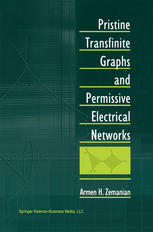

Most ebook files are in PDF format, so you can easily read them using various software such as Foxit Reader or directly on the Google Chrome browser.
Some ebook files are released by publishers in other formats such as .awz, .mobi, .epub, .fb2, etc. You may need to install specific software to read these formats on mobile/PC, such as Calibre.
Please read the tutorial at this link: https://ebookbell.com/faq
We offer FREE conversion to the popular formats you request; however, this may take some time. Therefore, right after payment, please email us, and we will try to provide the service as quickly as possible.
For some exceptional file formats or broken links (if any), please refrain from opening any disputes. Instead, email us first, and we will try to assist within a maximum of 6 hours.
EbookBell Team

5.0
108 reviewsA transfinite graph or electrical network of the first rank is obtained conceptually by connecting conventionally infinite graphs and networks together at their infinite extremities. This process can be repeated to obtain a hierarchy of transfiniteness whose ranks increase through the countable ordinals. This idea, which is of recent origin, has enriched the theories of graphs and networks with radically new constructs and research problems. The book provides a more accessible introduction to the subject that, though sacrificing some generality, captures the essential ideas of transfiniteness for graphs and networks. Thus, for example, some results concerning discrete potentials and random walks on transfinite networks can now be presented more concisely. Conversely, the simplifications enable the development of many new results that were previously unavailable. Topics and features: *A simplified exposition provides an introduction to transfiniteness for graphs and networks.*Various results for conventional graphs are extended transfinitely. *Minty's powerful analysis of monotone electrical networks is also extended transfinitely.*Maximum principles for node voltages in linear transfinite networks are established. *A concise treatment of random walks on transfinite networks is developed. *Conventional theory is expanded with radically new constructs. Mathematicians, operations researchers and electrical engineers, in particular, graph theorists, electrical circuit theorists, and probabalists will find an accessible exposition of an advanced subject.